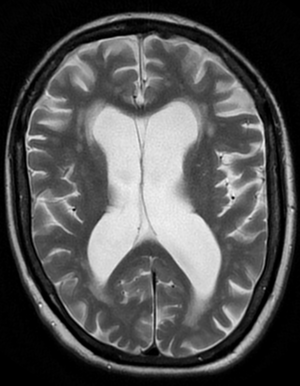
Back خرف وعائي Arabic Demència vascular Catalan Αγγειακή άνοια Greek Demencia vascular Spanish Dementzia baskular Basque زوال عقل عروقی Persian Vaskulaarinen dementia Finnish Démence vasculaire French שיטיון וסקולרי HE Demensia vaskular ID
| Vascular dementia | |
|---|---|
| Other names | Dementia due to cerebrovascular disease;[1] Vascular cognitive impairment[2] |
 | |
| Brain atrophy from vascular dementia | |
| Specialty | Psychiatry, neurology |
| Symptoms | Cognitive impairment, short-term memory loss[3] |
| Complications | Heart disease, loss of ability to care for self and interact, pneumonia[4] |
| Causes | Conditions that impair blood vessels in the brain and therefore interfere with oxygen delivery to the brain[3] |
| Risk factors | High blood pressure, high cholesterol, atrial fibrillation, diabetes[3] |
| Diagnostic method | Lab test, neuroimaging test, neuropsychological testing[5] |
| Differential diagnosis | Alzheimer’s disease[5] |
| Treatment | Symptomatic[3][4] |
| Frequency | 15-30% of dementia cases in the United States, Europe, and Asia[5][6] |
Vascular dementia is dementia caused by a series of strokes.[2][4] Restricted blood flow due to strokes reduces oxygen and glucose delivery to the brain, causing cell injury and neurological deficits in the affected region.[6] Subtypes of vascular dementia include subcortical vascular dementia, multi-infarct dementia, stroke-related dementia, and mixed dementia.[2][5]
Subcortical vascular dementia occurs from damage to small blood vessels in the brain. Multi-infarct dementia results from a series of small strokes affecting several brain regions. Stroke-related dementia involving successive small strokes causes a more gradual decline in cognition.[4] Dementia may occur when neurodegenerative and cerebrovascular pathologies are mixed, as in susceptible elderly people (75 years and older).[2][5] Cognitive decline can be traced back to occurrence of successive strokes.[4]
ICD-11 lists vascular dementia as dementia due to cerebrovascular disease.[1] DSM-5 lists vascular dementia as either major or mild vascular neurocognitive disorder.[7]
- ^ a b "ICD-11: Dementia due to cerebrovascular disease". World Health Organization. 2024. Retrieved 10 April 2024.
- ^ a b c d Iadecola C, Duering M, Hachinski V, Joutel A, Pendlebury ST, Schneider JA, et al. (July 2019). "Vascular Cognitive Impairment and Dementia". Journal of the American College of Cardiology. 73 (25): 3326–3344. doi:10.1016/j.jacc.2019.04.034. PMC 6719789. PMID 31248555.
- ^ a b c d "Vascular dementia". National Heart, Lung, and Blood Institute, US National Institutes of Health. 28 September 2022. Retrieved 10 April 2024.
- ^ a b c d e "Vascular dementia". MedlinePlus, US National Library of Medicine.
- ^ a b c d e Sanders AE, Schoo C, Kalish VB (22 October 2023). "Vascular dementia". StatPearls, US National Library of Medicine. PMID 28613567. Retrieved 9 April 2024.
- ^ a b Wong CE, Chui CH (June 2022). "Vascular cognitive impairment and dementia". Continuum. 28 (3): 750–780. doi:10.1212/CON.0000000000001124. PMC 9833847. PMID 35678401.
- ^ American Psychiatric Association (2013). Diagnostic and statistical manual of mental disorders : DSM-5 (5th ed.). Washington, DC: American Psychiatric Association. pp. 591–603. ISBN 978-0-89042-554-1.